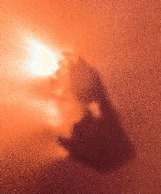 Energy --- | ---
Radiation
Energy --- | ---
Radiation

 Energy --- | ---
Radiation
Energy --- | ---
Radiation


Reading:
Chapter 2, 3-3 (ZG4)
 |
Key Question: | How do we know that the heliocentric model is "correct"? |
|---|---|---|
 |
Key Principle: | Angular Momentum Vector |
 |
Key Problem: | Why are all the planetary orbits approximately in the same plane? |
 |
Key Quote: | "At what point would you accept the heliocentric model over the geocentric model?" |
Check out the webpage from Scott Anderson of Emory University illustrating nicely the motion of the Earth. The animations are fairly effective.
The small angle formula tells us that the angle (in radians) subtended by an object of diameter D at distance r is:
 = D / r
= D / r This can be turned around in that if we observe an object shift direction by this angle (in radians) when we move a distance D perpendicular to its direction, then it must be at a distance r.

There are 206265 arcseconds (") in a radian, so the angular size of an object of diameter D at distance r is
 " = 206265 * D / r
" = 206265 * D / r If we use the baseline of the Earth's orbit (2 AU for 6 months apart) and see a shift of theta = 2 * p arcseconds, then
It is customary to define p as the parallax. Thus a parallax p of 1" means that the distance r is 206265 AU. If we define the unit of distance called the parsec to be 1 pc = 206265 AU, then
A star 1 parsec away has a parallax of 1 arcsecond. Talk about convenience! Note that 1 pc is about 3.26 light-years. The nearest star is around 1 pc away.
| Aristarchus | measured distance to Sun (incorrectly!) and discovered it to be much larger than the Earth |
| Copernicus | introduced heliocentric model which easily reproduced retrograde motion, but was inaccurate compared to Ptolemaic model |
| Kepler | Laws of Motion with elliptical orbits produce highly accurate heliocentric model, without epicycles |
| Galileo | observes phases of Venus and moons of Jupiter, and uses these to argue vociferously for heliocentric model over geocentric |
| Newton | Laws of Motion and Universal Gravitation explain Kepler's Laws, including comets, and provide physical basis for gravitation |
| 19th Century | binary stars discovered; stellar parallax and aberration measured |
| Einstein | General Theory of Gravitation extends Newtonian gravity; framework for cosmology and expanding universe models |
| Late 20th Century | Extrasolar planets found through pulsar timing and Doppler measurements of stellar radial velocities |
I didn't get to it in this lecture, but there have been a number of numerological attempts to explain the spacings of the planetary orbits in our solar system.
One such scheme, proposed in 1766 by Johann Titius and popularized later by Johan Elbert Bode, uses a series to approximate the orbital spacings of the planets. It has no solid physical basis, and can be thought of as a "fitting function". It was surprising that this rule, developed before the discovery of Uranus, Neptune, and Pluto, as well as the main belt asteroids such as Ceres, holds for nearly all the planets.
The rule can be written generally as:
for the semi-major axis an of the n-th orbit, where n takes on the values
 , 0, 1, 2, ...
, 0, 1, 2, ...
The constants p, b, q are determined by the first three orbits
| 1 | n = - | a = p | 0.4 AU | Mercury |
| 2 | n = 0 | a = p + b | 0.7 AU | Venus |
| 3 | n = 1 | a = p + b q | 1 AU | Earth |
thus p = 0.4, b=0.3, q=2. Check this for yourself!
This rule can also be written in recursive notation
where in our case q=2 and c=0.4.
The upshot for our solar system is that the following orbits are predicted:
| Orbit | n | an (AU) | Planet | a (AU) |
|---|---|---|---|---|
| 1 | - |
0.4 | Mercury | 0.39 |
| 2 | 0 | 0.7 | Venus | 0.72 |
| 3 | 1 | 1.0 | Earth | 1.00 |
| 4 | 2 | 1.6 | Mars | 1.52 |
| 5 | 3 | 2.8 | Ceres | 2.77 |
| 6 | 4 | 5.2 | Juptier | 5.20 |
| 7 | 5 | 10.0 | Saturn | 9.54 |
| 8 | 6 | 19.6 | Uranus | 19.19 |
| 9 | 7 | 38.8 | Neptune | 30.06 |
| 10 | 8 | 77.2 | Pluto? | 39.53 |
Note that the largest main belt asteroid Ceres fits the n=3 orbit. Also, the n=7 orbit seems to be best fit by an average of Neptune and Pluto. Perhaps "Planet X" could lurk out at 77 AU, and Pluto is just an interloper.
Last year, I noticed a paper on fitting random stable solar systems (from simulations) to a Titius-Bode law. If you are interested, you can find this on the LANL Astro-PH Preprint Archive.
 Prev Lecture ---
Prev Lecture ---
 Next Lecture ---
Next Lecture ---
 Astr11 Index ---
Astr11 Index ---
 Astr11 Home
Astr11 Home
smyers@nrao.edu Steven T. Myers